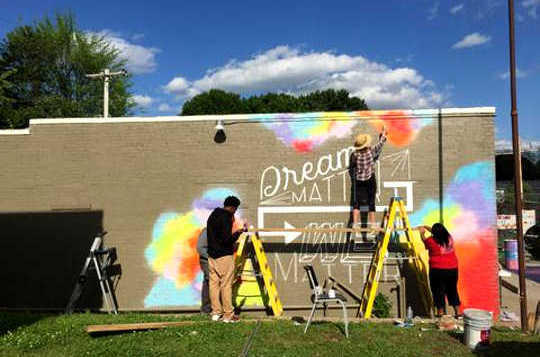
Community groups have the power to create long-lasting change. Ioby, an organization based in New York City, New York, that works on neighborhood mobilization, recently published its "Recipes for Change" toolkit. The guide is brimming with tips on how to organize, launch, and promote community-based projects. It's a must read if you're interested in starting a community garden, tool library, or other sharing projects in your neighborhood.
Here are some key points mentioned in the guide:
1. Start with what's already there using ABCD
Asset-based community development (ABCD) is an approach focused on helping communities evolve and flourish using existing resources such as sidewalks, corner stores, local parks, and churches. Essence Jackson, program coordinator at Livable Memphis, says:
"Before you do any project — before you even start using ABCD as a methodology — make your first step figuring out if the neighborhood actually wants to do what you have in mind. Often, when government or other local leaders come into a neighborhood from outside and say, 'We're going to do XYZ here' and don't ask people first, residents won't feel good about the change and won't help it to succeed. So before you get started with anything, make sure to ask around — on the street, in church, at school — if people like the idea. If you get positive reactions, you can start pulling in public participation. ... People need to feel a stake in the process. They need to feel empowered and have a voice, or they won’t stay involved. (Plus, of course, these people's skills comprise some of the assets your project will need to succeed) Inviting this kind of leadership involvement is also the key to keeping momentum once your project is underway."
2. Involve neighbors and local stakeholders
Community organizers need to have a variety of diverse perspectives and participation from many people. Siphne Sylve, a visual artist, musician, and project manager at the UrbanArt Commission, offers the following tips:
- Know what you want.
- Know what your stakeholders want.
- Talk to everyone directly.
- Keep everyone on the same page with project goals.
- Understand your group and how they like to work.
- Break large groups down into committees.
3. Engage with local elected officials and agencies
Local officials may be able to help with resources, permissions, endorsements, and leveraging press opportunities. To approach and work with officials and agencies, David Bragdon, executive director at TransitCenter, advises:
- Adopt a spirit of cooperation.
- Find places where your objectives align with theirs.
- Connect with them early to help get your project off the ground.
- Make presentations concise and to-the-point with visual aids to help tell your story.
4. Keep volunteers happy and engaged
Having a team of engaged volunteers who understand the project vision and are committed to seeing it through is a vital part of creating a strong community-based project. Rebecca Matlock Hutchinson, site director of Soulsville, USA, offers these tips for keeping volunteers happy and engaged:
- Keep people posted. When they know what's happening and feel they can express their opinion, that gains you credibility, respect, and trust.
- Don't make assumptions. Outright ask them: They might know someone or be interested in something you might never have guessed.
- Espouse the benefits. People want to know that what they're doing is making a difference.
- Express gratitude. Always provide food, drinks, and the right tools for the job. Make sure people are comfortable. Thank-you letters, certificates, t-shirts, and volunteer picnics are inexpensive, but important gestures.
- Mark your milestones. When you've reached a goal or passed an anniversary, celebrate it.
See ioby's Recipes for Change guide for more expert tips and resources. All photos of community groups around the U.S. courtesy of ioby. Follow @CatJohnson on Twitter.
About The Author
 Cat Johnson is a freelance writer focused on community, the commons, sharing, collaboration and music. Publications include Utne Reader, GOOD, Yes! Magazine, Shareable, Triple Pundit and Lifehacker. She's also a musician, record store longtimer, chronic list maker, avid coworker and aspiring minimalist. Follow her @CatJohnson on Twitter and Facebook, Cat Johnson's Blog.
Cat Johnson is a freelance writer focused on community, the commons, sharing, collaboration and music. Publications include Utne Reader, GOOD, Yes! Magazine, Shareable, Triple Pundit and Lifehacker. She's also a musician, record store longtimer, chronic list maker, avid coworker and aspiring minimalist. Follow her @CatJohnson on Twitter and Facebook, Cat Johnson's Blog.
Related Books
at InnerSelf Market and Amazon




























